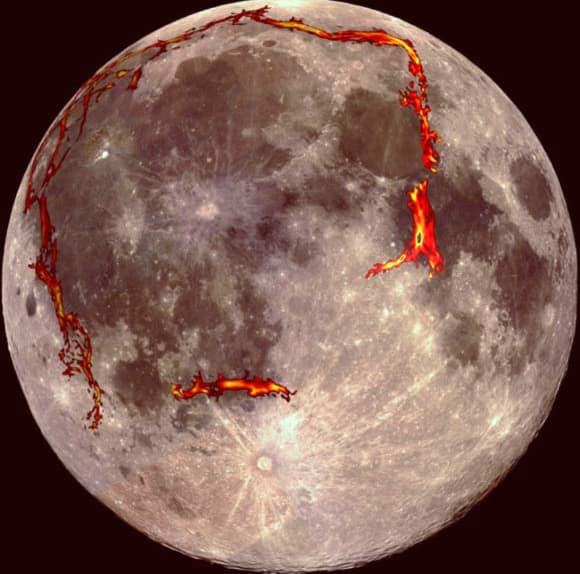The Oceanus Procellarum (Ocean of Storms) is the largest of the lunar maria (seas) covering roughly 4 million square kilometers (about the surface area of the EU). Its wide flat basaltic surface was believed to be the result of a major impact on the Moon surface in the early days of our satellite, which was consequentially filled with magma.
The latest analysis from the NASA’s Gravity Recovery and Interior Laboratory (GRAIL) mission show that the underlying structure of the Procellarum region is not ellipsoidal (as expected in an impact event) but quasi-rectangular with well defined borders. Those borders are ancient rifts in the lunar surface filled with now solidified lava, and their nature and geometry implies that the Ocean of Storms was created after a series of volcanic events. The event is quite interesting in its own right. The surface of the Moon cracked due to thermal stresses: this was due to differential cooling (the procellarum region relative to its surroundings) and to volcanic activity driven by the greater-than-average heat flux.

This picture shows the surface of the Moon, with the newly discovered rifts highlighted in red and surrounding the Procellarum region. Credit: Kopernik Observatory / NASA / Colorado School of Mines / MIT / JPL / Goddard Space Flight Center.
This phenomenon is new for the Moon (and on this scale) but it has been observed on Earth for a very long time; hexagonal basaltic structure, such as the striking Giant’s Causeway in Northern Ireland, form in the same manner we now think the Ocean of Storms formed 3.5 billion years ago.
REFERENCE
Structure and evolution of the lunar Procellarum region as revealed by GRAIL gravity data, Jeffrey C. Andrews-Hanna et al. Nature 514, 68–71(02 October 2014).

